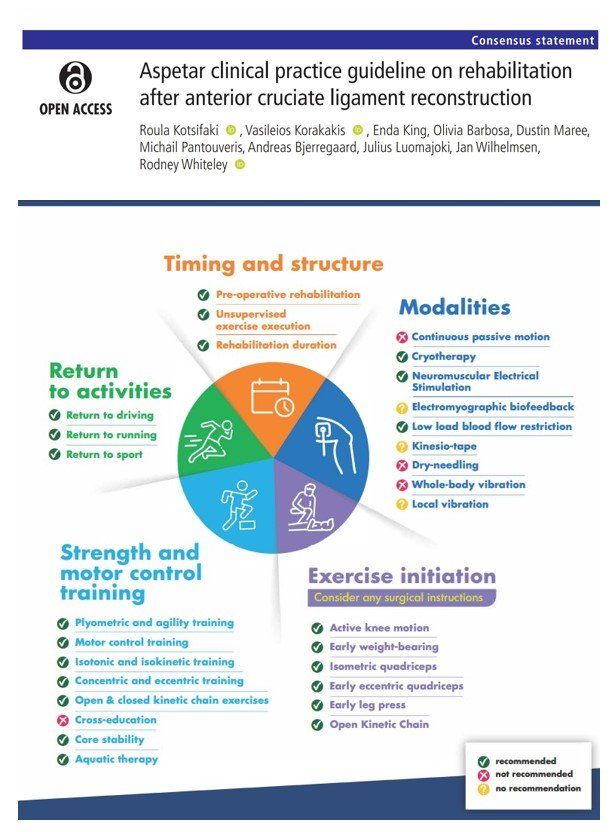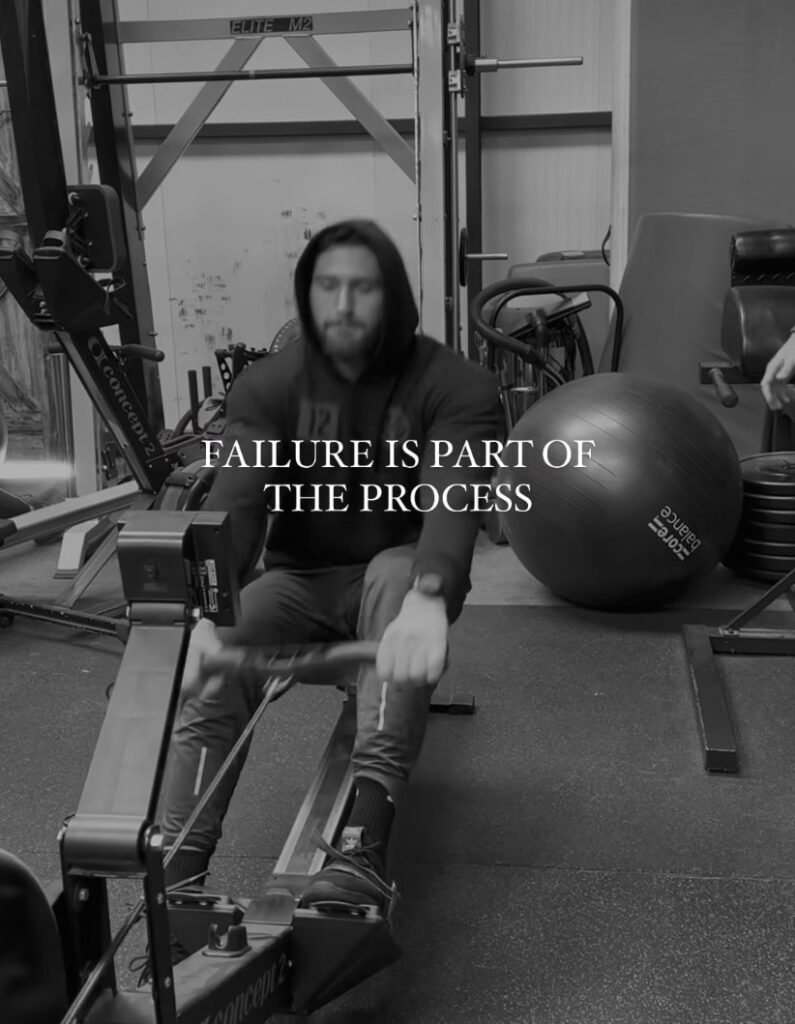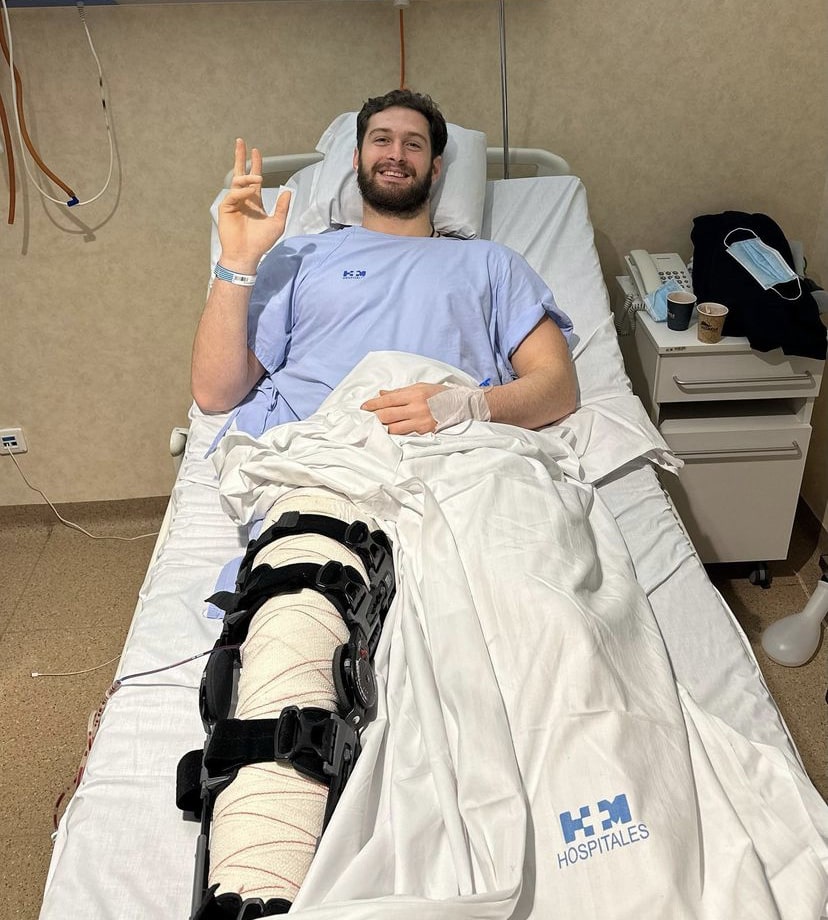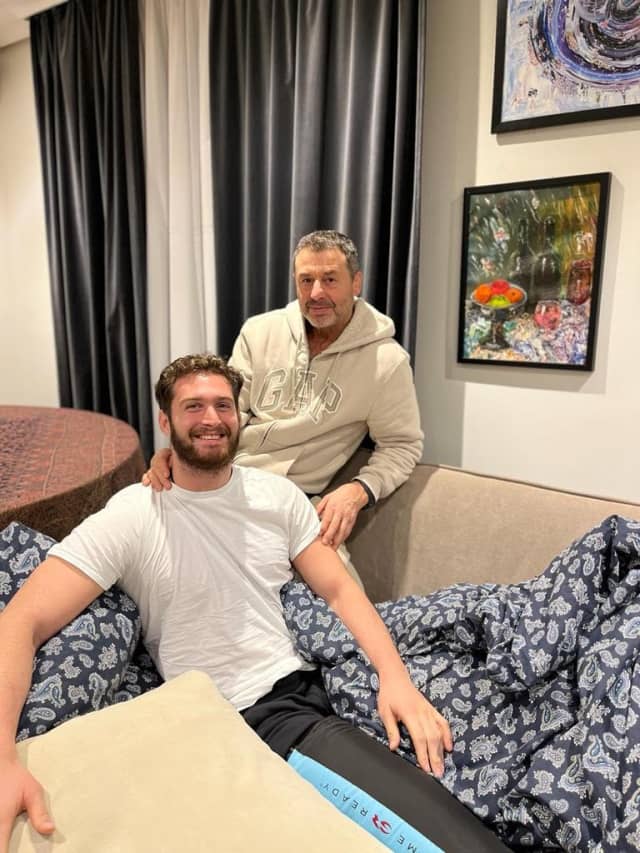Rehabilitation after ACL reconstruction
One month ago Niko Sherazadishvili announced on his social media “Surgery went well. Overwhelmed by all the love and support everyone sent my way”. During Master competition in Jerusalem he suffered a torn anterior cruciate ligament (IJF article) and on 3rd January he was operated successfully.
High prevalence of anterior cruciate ligament injuries (ACL) in judokas has been reported previously (Koshida et al. 2010), and a research carried out by Lambert et al. (2020) about the return to competition after ACL injury concluded that significant discrepancies between the medical treatment regarding the recommendations of doctors and physiotherapists compared to athletes behavior.
Kotsifaki et al. (2023) have just published an interesting guideline that was developed to inform clinical practice on rehabilitation after anterior cruciate ligament reconstruction (ACLR). Check out here the recommendations for the components of rehabilitation after ACL surgery based on the available evidence.

ABSTRACT
This guideline was developed to inform clinical practice on rehabilitation after anterior cruciate ligament reconstruction (ACLR) and was performed in accordance with the Appraisal of Guidelines for REsearch & Evaluation II (AGREE II) instrument and used the Grading of Recommendations, Assessment, Development and Evaluation (GRADE) approach. A Guideline Development Group systematically searched and reviewed evidence using randomised clinical trials and systematic reviews to evaluate the effectiveness of rehabilitation interventions and guide clinicians and patients on the content of the optimal rehabilitation protocol after ACLR.
The guideline targets patients during rehabilitation
after ACLR and investigates the effectiveness of the available interventions to the physiotherapist, alone
or in combination (eg, exercise, modalities, objective progression criteria). Exercise interventions should be considered the mainstay of ACLR rehabilitation. However, there is little evidence on the dose–response relationship between volume and/or intensity of exercise and outcomes. Physical therapy modalities can be helpful as an adjunct in the early phase of rehabilitation when pain, swelling and limitations in range of motion are present. Adding modalities in the early phase may allow earlier pain-free commencement of exercise rehabilitation. Return to running and return to training/activity are key milestones for rehabilitation after ACLR. However, there is no evidence on which progression or discharge criteria should be used.
While there is a very low level of certainty for most components of rehabilitation, most of the recommendations provided in this guideline were agreed to by expert clinicians. This guideline also highlights several new elements of ACLR management not reported previously.
Download the full article HERE.

Summary of the recommendations on rehabilitation after anterior cruciate ligament reconstruction.





Sustain the excellent work and producing in the group!
Sewing Machines… […]any time to read or go to the content or perhaps internet sites we certainly have associated with[…]…
How can I find out more about it?
May I request that you elaborate on that? Your posts have been extremely helpful to me. Thank you!
The heart of your writing whilst sounding reasonable at first, did not settle perfectly with me personally after some time. Somewhere throughout the sentences you actually managed to make me a believer unfortunately just for a while. I however have a problem with your jumps in assumptions and you might do nicely to help fill in those breaks. In the event that you actually can accomplish that, I could surely end up being fascinated.
I was more than happy to seek out this internet-site.I wanted to thanks in your time for this wonderful read!! I undoubtedly enjoying each little bit of it and I’ve you bookmarked to take a look at new stuff you weblog post.
I absolutely love your blog and find most of your post’s to be exactly what I’m looking for. Does one offer guest writers to write content for yourself? I wouldn’t mind creating a post or elaborating on a lot of the subjects you write in relation to here. Again, awesome website!
Hi there! Quick question that’s completely off topic. Do you know how to make your site mobile friendly? My website looks weird when browsing from my iphone 4. I’m trying to find a theme or plugin that might be able to correct this issue. If you have any recommendations, please share. With thanks!
I am really enjoying the theme/design of your blog. Do you ever run into any browser compatibility problems? A couple of my blog readers have complained about my website not operating correctly in Explorer but looks great in Opera. Do you have any recommendations to help fix this issue?
Please let me know if you’re looking for a author for your weblog. You have some really great posts and I feel I would be a good asset. If you ever want to take some of the load off, I’d really like to write some material for your blog in exchange for a link back to mine. Please blast me an e-mail if interested. Thanks!
Along with every thing that seems to be developing throughout this specific area, a significant percentage of points of view happen to be fairly refreshing. Even so, I beg your pardon, because I can not subscribe to your entire theory, all be it exciting none the less. It appears to everyone that your comments are actually not completely validated and in simple fact you are generally your self not completely convinced of the point. In any event I did enjoy looking at it.
Hello there, just became alert to your blog through Google, and found that it is truly informative. I抦 gonna watch out for brussels. I will appreciate if you continue this in future. A lot of people will be benefited from your writing. Cheers!
you are really a good webmaster. The web site loading speed is incredible. It seems that you are doing any unique trick. Moreover, The contents are masterwork. you have done a great job on this topic!
Very well written article. It will be supportive to everyone who employess it, including yours truly :). Keep up the good work – for sure i will check out more posts.
Hey There. I found your blog using msn. This is an extremely well written article. I will make sure to bookmark it and return to read more of your useful info. Thanks for the post. I抣l certainly comeback.
Hey I am so glad I found your website, I really found you by accident, while I was searching on Askjeeve for something else, Nonetheless I am here now and would just like to say thank you for a tremendous post and a all round exciting blog (I also love the theme/design), I don抰 have time to browse it all at the moment but I have book-marked it and also added in your RSS feeds, so when I have time I will be back to read a great deal more, Please do keep up the awesome job.
I was suggested this website by my cousin. I’m not sure whether this post is written by him as no one else know such detailed about my trouble. You are wonderful! Thanks!
Wow! This blog looks just like my old one! It’s on a completely different topic but it has pretty much the same page layout and design. Great choice of colors!
When I originally commented I clicked the “Notify me when new comments are added” checkbox and now each time a comment is added I get three e-mails with the same comment. Is there any way you can remove people from that service? Thank you!
Thanks for the new stuff you have unveiled in your article. One thing I want to comment on is that FSBO human relationships are built after a while. By releasing yourself to the owners the first saturday and sunday their FSBO is actually announced, prior to a masses start calling on Mon, you build a good interconnection. By mailing them equipment, educational elements, free accounts, and forms, you become the ally. By subtracting a personal desire for them and their scenario, you develop a solid network that, on most occasions, pays off when the owners decide to go with a real estate agent they know in addition to trust – preferably you.
Download Essence Cash Nude Photos – https://crocspot.fun
I have come across that right now, more and more people are attracted to video cameras and the industry of images. However, being photographer, you must first shell out so much time deciding the exact model of digicam to buy and also moving via store to store just so you could buy the most affordable camera of the brand you have decided to select. But it doesn’t end generally there. You also have to take into consideration whether you should obtain a digital digital camera extended warranty. Thanks a lot for the good points I obtained from your site.
Downloaded Exactly E Only Fans Leaks – https://t.me/UCSTG
Циклёвка паркета: особенности и этапы услуги
Циклёвка паркета — это процесс восстановления внешнего вида паркетного пола путём удаления верхнего повреждённого слоя и возвращения ему первоначального вида. Услуга включает в себя несколько этапов:
Подготовка: перед началом работы необходимо защитить мебель и другие предметы от пыли и грязи, а также удалить плинтусы.
Шлифовка: с помощью шлифовальной машины удаляется старый лак и верхний повреждённый слой древесины.
Шпатлёвка: после шлифовки поверхность паркета шпатлюется для заполнения трещин и выравнивания поверхности.
Грунтовка: перед нанесением лака паркет грунтуется для улучшения адгезии и защиты от плесени и грибка.
Нанесение лака: лак наносится в несколько слоёв с промежуточной шлифовкой между ними.
Полировка: после нанесения последнего слоя лака паркет полируется для придания поверхности блеска и гладкости.
Циклёвка паркета позволяет обновить внешний вид пола, восстановить его структуру и продлить срок службы.
Сайт: ykladka-parketa.ru
Циклевка паркета
Лендинг-пейдж — это одностраничный сайт, предназначенный для рекламы и продажи товаров или услуг, а также для сбора контактных данных потенциальных клиентов. Вот несколько причин, почему лендинг-пейдж важен для бизнеса:
Увеличение узнаваемости компании. Лендинг-пейдж позволяет представить компанию и её продукты или услуги в выгодном свете, что способствует росту узнаваемости бренда.
Повышение продаж. Заказать лендинг можно здесь – 1landingpage.ru Одностраничные сайты позволяют сосредоточиться на конкретных предложениях и акциях, что повышает вероятность совершения покупки.
Оптимизация SEO-показателей. Лендинг-пейдж создаются с учётом ключевых слов и фраз, что улучшает позиции сайта в результатах поиска и привлекает больше целевых посетителей.
Привлечение новой аудитории. Одностраничные сайты могут использоваться для продвижения новых продуктов или услуг, а также для привлечения внимания к определённым кампаниям или акциям.
Расширение клиентской базы. Лендинг-пейдж собирают контактные данные потенциальных клиентов, что позволяет компании поддерживать связь с ними и предлагать дополнительные услуги или товары.
Простота генерации лидов. Лендинг-пейдж предоставляют краткую и понятную информацию о продуктах или услугах, что облегчает процесс принятия решения для потенциальных клиентов.
Сбор персональных данных. Лендинг-пейдж позволяют собирать информацию о потенциальных клиентах, такую как email-адрес, имя и контактные данные, что помогает компании лучше понимать свою аудиторию и предоставлять более персонализированные услуги.
Улучшение поискового трафика. Лендинг-пейдж создаются с учётом определённых поисковых запросов, что позволяет привлекать больше целевых посетителей на сайт.
Эффективное продвижение новой продукции. Лендинг-пейдж можно использовать для продвижения новых товаров или услуг, что позволяет привлечь внимание потенциальных клиентов и стимулировать их к покупке.
Лёгкий процесс принятия решений. Лендинг-пейдж содержат только самую необходимую информацию, что упрощает процесс принятия решения для потенциальных клиентов.
В целом, лендинг-пейдж являются мощным инструментом для продвижения бизнеса, увеличения продаж и привлечения новых клиентов.
Заказать лендинг
I抳e read some just right stuff here. Definitely worth bookmarking for revisiting. I surprise how so much effort you put to create the sort of wonderful informative site.
It’s rare to find content that strikes a perfect balance between informative and engaging, but your posts consistently hit the mark. Your ability to delve into complex topics and make them understandable is invaluable. Thank you for elevating the discourse in your field.
Beautifully written and incredibly informative, The post has made a lasting impression on me. Thank you for sharing The thoughts.
I’m so grateful for the information you’ve shared. It’s been incredibly enlightening!
I must admit, The depth of analysis is as attractive as The words. Great work has never looked so good.
The words are like seeds, planting ideas that blossom into understanding and appreciation.
Genuinely impressed by The analysis. I was starting to think depth had gone out of style. Kudos for proving me wrong!
The insights are like a sunrise, bringing light and warmth to new ideas.
The voice shines through The writing like a beacon, guiding us through the darkness of ignorance.
The writing style had me at hello. Engaged from start to finish, just like a perfect first date.
purple pharmacy mexico price list
https://cmqpharma.com/# mexican online pharmacies prescription drugs
buying prescription drugs in mexico online
buying prescription drugs in mexico online: mexican pharmacy – buying prescription drugs in mexico online
как дойти до торгового центра москва
устроиться на работу метрополитен москва без опыта где можно расплачиваться картой тройка
москва намаз москве ноябрь
https://canadapharmast.online/# canadianpharmacyworld com
mexican pharmaceuticals online mexico drug stores pharmacies buying prescription drugs in mexico online
my canadian pharmacy: certified canadian pharmacy – northern pharmacy canada
top online pharmacy india: online shopping pharmacy india – world pharmacy india
legit canadian pharmacy online canadapharmacyonline cheap canadian pharmacy online
https://canadapharmast.online/# canadian drug
best online pharmacies in mexico: mexican border pharmacies shipping to usa – mexico pharmacy
Youre so cool! I dont suppose Ive read anything such as this prior to So nice to get somebody by original thoughts on this subject realy thanks for beginning this up this amazing site is one thing that is required on the net, someone with some originality beneficial job for bringing a new challenge towards net!
reputable mexican pharmacies online: п»їbest mexican online pharmacies – purple pharmacy mexico price list
pharmacy canadian superstore cheapest pharmacy canada canadian pharmacy 365
http://indiapharmast.com/# online pharmacy india
mexican pharmaceuticals online: mexico drug stores pharmacies – mexican pharmacy
mexican drugstore online: reputable mexican pharmacies online – buying prescription drugs in mexico
online pharmacy india: indian pharmacy – indianpharmacy com
http://clomiddelivery.pro/# can i get cheap clomid without rx
Pingback: ตรวจดาวน์ซินโดรม
https://paxloviddelivery.pro/# buy paxlovid online
http://paxloviddelivery.pro/# paxlovid cost without insurance
http://ciprodelivery.pro/# buy cipro online canada
http://paxloviddelivery.pro/# paxlovid pharmacy
https://amoxildelivery.pro/# generic amoxicillin over the counter
https://doxycyclinedelivery.pro/# doxycycline prescription cost uk
https://ciprodelivery.pro/# ciprofloxacin generic
Sur notre site web, vous pouvez consulter toutes les actualites concernant les medias en Afrique. Nous couvrons une variete de sujets, incluant les dernieres nouvelles dans les secteurs de la television, de la radio et de la presse ecrite, aux progres dans les medias numeriques et les reseaux sociaux https://africanmedia.africa/l-acteur-neil-cruz-connu-sous-le-nom-de-maa-bea.html. Notre equipe de journalistes experimentes et de correspondants locaux s’efforce sans relache pour vous apporter des actualites precises et a jour.
Nous apportons une attention particuliere aux progres et aux tendances qui transforment le paysage mediatique africain. Que ce soit la montee des plateformes de streaming, la presence croissante des blogs et des podcasts, ou l’effet des politiques gouvernementales sur la liberte de la presse, vous trouverez des analyses detaillees et des reportages exclusifs sur notre site. Nous portons egalement en lumiere les initiatives locales et les talents emergents qui aident a structurer l’avenir des medias sur le continent.
En plus des actualites, notre site presente des interviews avec des personnalites influentes du secteur des medias et des experts, ainsi que des articles d’opinion rediges par des specialistes. Nous encourageons nos lecteurs a prendre part activement en publiant des commentaires et en partageant leurs points de vue. Rendez-nous visite des aujourd’hui pour etre informe et engage avec les mouvements passionnantes du monde des medias en Afrique.